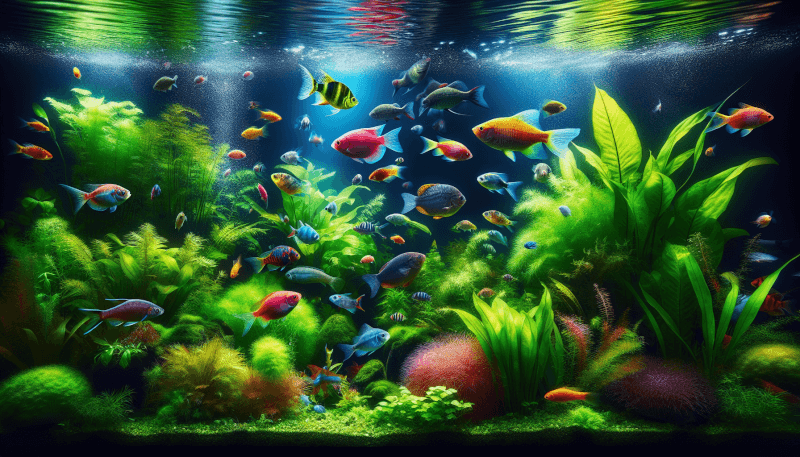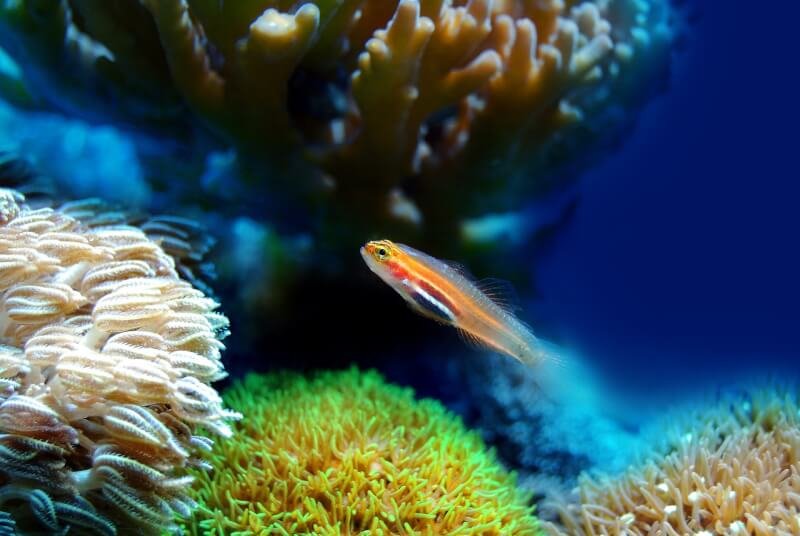Are you looking to add a touch of beauty to your aquarium? Look no further! This beginner’s guide is here to help you enhance the aesthetics of your aquarium and create a visually stunning underwater world. From selecting the right plants and decorations to mastering the art of lighting and color schemes, we’ll provide you with all the tips and tricks you need to transform your aquarium into a vibrant and captivating oasis for your aquatic friends. Get ready to take your aquarium to the next level and create a stunning centerpiece in your home.
Choosing the Right Aquarium
When it comes to setting up an aquarium, choosing the right one is crucial. There are several factors to consider, starting with the size and shape of the aquarium. The size of your tank will depend on the space you have available and the number of fish you plan to keep. As a general rule, it’s always better to opt for a larger tank as it provides a more stable environment for your fish and offers more room for decorations and plants. As for the shape, there are various options available, including rectangular, square, round, and even hexagonal tanks. Think about which shape would complement your space and provide the best viewing angles.
Another important consideration when choosing an aquarium is the material it is made of. Glass and acrylic are the two most common options. Glass tanks are sturdy and scratch-resistant, but they tend to be heavier than acrylic tanks. On the other hand, acrylic tanks are lighter and more impact-resistant, making them a popular choice for larger tanks. However, they are more prone to scratches, so extra care should be taken when cleaning them. Ultimately, the choice between glass and acrylic will depend on your specific needs and preferences.
Lastly, you need to decide whether you want a freshwater or saltwater aquarium. Freshwater aquariums are generally easier to maintain and are ideal for beginners. They offer a wide range of fish species to choose from and require less equipment. Saltwater aquariums, on the other hand, offer a more diverse array of fish and invertebrates, but they are more challenging to set up and maintain. They require specialized equipment, such as protein skimmers and high-quality filtration systems. Consider your level of experience and the amount of time and effort you are willing to invest before making a decision.
Setting Up the Aquarium
Once you have chosen the perfect aquarium, it’s time to set it up. Selecting the ideal location is crucial for the well-being of your aquatic pets. Avoid placing the tank in direct sunlight or near sources of heat, as these can lead to temperature fluctuations and algae growth. It’s also essential to choose a sturdy surface that can support the weight of the aquarium when filled with water.
Next, assemble all the necessary equipment. This includes a filter, heater, thermometer, lighting system, and any other accessories specific to the type of aquarium you are setting up. Make sure to carefully read the instructions and set up each piece of equipment correctly to ensure optimal performance.
Before adding water to the tank, it’s important to prepare it properly. Fill the tank with dechlorinated water and add a dechlorinator to remove any harmful chemicals. Allow the water to circulate and stabilize for at least 24 hours to create a suitable environment for your fish.
Adding Substrate and Decorations
Choosing the right substrate is an essential step in creating a healthy and visually appealing aquarium. Substrate serves as a natural filter and provides a surface for beneficial bacteria to grow, which helps maintain water quality. Choose a substrate that suits the needs of your fish and plants. For example, a fine-grained substrate like sand is ideal for bottom-dwelling fish, while larger gravel works well for fish that like to burrow.
Incorporating natural elements into your aquarium enhances its aesthetic appeal and provides a more realistic environment for your aquatic pets. Adding live plants not only adds beauty but also helps oxygenate the water and provide hiding places for fish. Select a variety of plants that are compatible with your setup and offer a mix of different colors, shapes, and textures.
While natural elements are crucial, you may also consider adding artificial decorations to create a more visually stimulating environment. Artificial rocks, caves, and driftwood can provide additional hiding spots and create focal points in your aquarium. Just make sure to choose decorations that are fish-safe and won’t harm your aquatic inhabitants.
Selecting Suitable Plants
When selecting plants for your aquarium, it’s important to choose ones that are easy to maintain, especially if you’re a beginner. Some popular choices for low-maintenance plants include Java Fern, Anubias, and Java Moss. These plants require minimal care and can thrive in a variety of lighting conditions.
Consider the lighting requirements of the plants you choose. Some plants require high-intensity lighting, while others can flourish in low-light conditions. Be sure to match the needs of your plants with an appropriate lighting system to promote healthy growth.
Creating a balanced plant arrangement is key to enhancing the aesthetics of your aquarium. Arrange plants of different heights, textures, and densities to create depth and visual interest. Place taller plants in the background and shorter ones in the foreground to create a sense of perspective. Don’t be afraid to experiment and get creative with your arrangement to achieve the desired look.
Introducing Fish and Invertebrates
Now comes the exciting part – introducing fish and invertebrates to your aquarium. Before adding any fish, it’s crucial to research and ensure they are compatible with one another. Consider factors such as fish size, temperament, and water parameter requirements. Some species may be territorial or aggressive toward others, while some require specific water conditions to thrive.
Establishing an appropriate population is important to maintain a healthy balance in your aquarium. Overcrowding can lead to stress, disease, and poor water quality. Consult with a knowledgeable aquarium specialist to determine the appropriate number of fish based on the size of your tank and the needs of the species you choose.
Adding invertebrates, such as shrimp or snails, can be a great way to add diversity to your aquarium. They serve as natural cleaners and can help control algae growth. Just like with fish, ensure that the invertebrates you choose are compatible with your desired water parameters and fish species.
Maintaining Water Quality
Maintaining the water quality in your aquarium is crucial for the health and well-being of your aquatic pets. Regular water testing is essential to monitor ammonia, nitrite, nitrate, pH, and other important parameters. This helps ensure that the water conditions are suitable for your fish and plants. Test kits are readily available at most pet stores and are simple to use.
Regular water changes are necessary to remove accumulated waste, excess nutrients, and toxins from the aquarium. Perform partial water changes every one to two weeks, replacing around 10-20% of the water. This helps maintain a healthy balance and keeps the water chemistry stable.
Monitoring and controlling temperature and pH levels are also important. Invest in a reliable aquarium heater to maintain a stable temperature suitable for your fish species. pH can be adjusted using commercial pH adjusters if necessary, but it’s important to do so gradually to avoid shocking or stressing the fish.
Creating a Stimulating Environment
Creating a visually stimulating environment not only enhances the aesthetics of your aquarium but also provides enrichment for your fish. Provide sufficient hiding spaces by incorporating live plants, caves, and rocks. This helps create a sense of security for your fish and allows them to exhibit natural behaviors.
Aquatic driftwood and rocks can add a natural touch to your aquarium and provide additional hiding places. Just ensure that the driftwood has been properly soaked to remove any excess tannins that may discolor the water.
In addition to natural elements, you can also create artificial caves and structures to add visual interest and complexity to your aquarium. These can be made from non-toxic materials such as PVC pipes or aquarium-safe resin. Aim for a balance between open spaces and hiding spots to cater to the needs of different fish species.
Choosing the Right Lighting
Choosing the right lighting for your aquarium is crucial for the health and growth of your fish and plants. Different fish and plants have varying lighting needs, so it’s important to consider these requirements when selecting a lighting system.
First, determine whether your tank setup requires low, moderate, or high-intensity lighting. Some fish and plants thrive in low-light conditions and may even be negatively affected by bright lights. On the other hand, high-light plants require intense lighting to photosynthesize and grow.
Consider the duration and intensity of the lighting. Most aquariums require 8-12 hours of lighting per day, but this can vary depending on the specific needs of your setup. Too much or too little light can lead to algae growth or inhibit plant growth. Aim for a balance that promotes healthy photosynthesis and fish behaviors.
When selecting a lighting system, choose one that is appropriate for the size and depth of your tank. LED lights are energy-efficient and have a long lifespan, making them a popular choice among aquarium enthusiasts. They also come in a variety of colors, allowing you to customize the look of your aquarium.

Installing a Filtration System
A filtration system is an essential component of any aquarium setup. It helps maintain water quality by removing waste, excess nutrients, and toxins. There are different types of filtration systems available, and understanding the differences can help you make an informed decision.
Mechanical filtration removes debris and particles from the water, while biological filtration utilizes beneficial bacteria to break down harmful substances. Chemical filtration involves using activated carbon or other chemical media to remove impurities from the water.
When selecting a filtration system, consider the size of your tank, the number and size of fish, and the specific needs of your setup. Canister filters are a popular choice as they offer both mechanical and biological filtration in one unit. Hang-on-back filters are easy to install and maintain, making them suitable for beginners.
Regardless of the filtration system you choose, proper maintenance is crucial. Regularly clean the filter media and replace it as needed to ensure optimal performance. Remember to follow the manufacturer’s instructions for maintenance and cleaning.
Conclusion
Setting up and maintaining an aquarium can be an enjoyable and rewarding experience. By choosing the right aquarium, setting it up correctly, and providing a stimulating environment, you can create a beautiful and thriving underwater world for your fish and invertebrates. Remember to research fish compatibility, maintain water quality, and choose suitable lighting and filtration systems. With proper care and attention, your aquarium will become a mesmerizing centerpiece in any room, bringing you hours of relaxation and enjoyment.



